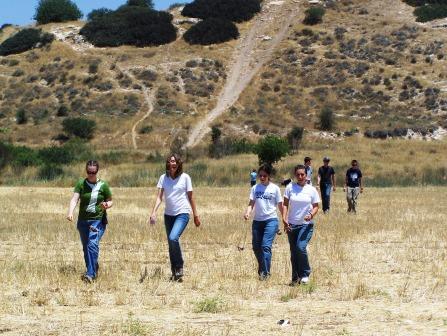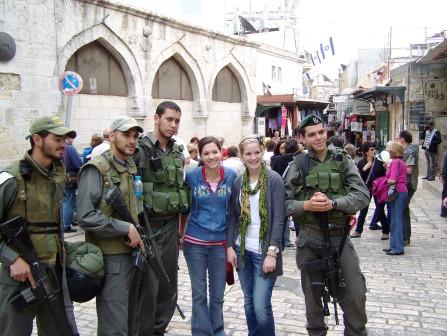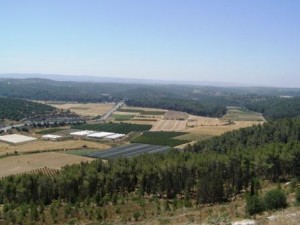Today we went on a tour of the Shephelah which is the Judean hill country between the crest of the mountains (the way of the patriarchs where all the major cities are like Jerusalem and Bethlehem) and the coastal plain. The Shephelah is famous for its many valleys that act as natural roads into the highlands. As a result of this they were often good places for fortified cities. They are also where the battles between the Israelites and the Philistines took place. Israel reigned in the high country while the Philistines controlled the coastal areas as the Sea people. The Philistines were constantly fighting their way up the valleys with the hope of eventually gaining control of the highlands. Israel responded by building settlements and fortresses overlooking the valleys. We visited a bunch of these sites including the Zorah, the place where Samson was born, Beth Shemesh, where the Ark of the Covenant was returned to Israel after passing some time in Philistine control. We also visited Azekah which overlooked the Elah valley where two famous champions, David and Goliath faced each other. We also briefly stopped at Lachish and Mareshah, two cities mentioned in the bible in context of various invasions and battles.
Lachish was particularly interesting because the remains of the siege ramp from the Assyrian conquest are still visible. They found a pile of pot shards there with writing on them that turned out to be the correspondence between the general and various outposts during the siege. So we have a little insight into what happened there. There were also ruins of a temple looking building there. Temple in the sense that it was three tiered. Each chamber inside of the other with steps leading up to the center just like the temple in Jerusalem.
The message of these ruins all over the place is a sad story of the Judges, the early Judean kings, and the waning Jewish empire leading up to their eventual conquest. Sometimes these cities stood strong and conquered their goliaths. Other times the Assyrians would breach the wall and destroy the city. The key factor always seemed to be obedience to God. When Israel listened to its prophet, be it David (yes), Samson (yes), Isaiah (yes in this case) or Jeremiah (no), the city was saved usually by miracle. God controls very much who is permitted to live in these hills.
We learned another interesting point. The word Palestine comes from the Philistines. The Romans started using the term after the Jewish revolted the 2nd time in place of Judea. In Latin the word was transformed to the Palestine that we know but in Arabic it is still Philistine. Thus even today the conflict, which erupted violently while we traveled the hill country, is between the modern rendition of Israel and the modern equivalent of the Philistines. The territory is nearly the same, and the bloodlines remain cruelly locked. Perhaps this is one of the longest blood feuds in world history.
We have been restricted from the old city and East Jerusalem for a few days but we are fine. We are very much interested in the results of the ship boarding experience. From here it very much appears that Israel was provoked and set up for an international scandal, the offending ships knowingly went into forbidden waters. I suspect long term effects will be pretty minor. In the mean time I suppose we will actually study for the upcoming midterms.
In pondering the ongoing conflict I must ponder when peace will come. It seems not many people want peace although most are praying for it. I remembered a story told by my hero Gordon B Hinckley which I shall re-post here.
Perhaps a few more prayers will further help this troubled land.
I had a long-remembered meeting with Mr. Shimon Peres of Israel. He was a former prime minister. He had seen much of conflict and trouble in his time.
I asked him whether there was any solution to the great problems that constantly seem to divide the people of Israel and the Palestinians. He replied, “Of course there is.”
As I recall, he said, “When we were Adam and Eve, we were all one. Is there any need for us now to be divided into segments with hatred for one another?”
He told a very interesting story that he said he had heard from a Muslim. The Muslim told of a Jewish rabbi who was conversing with two of his friends. The rabbi asked one of the men, “How do you know when the night is over and a new day has begun?”
His friend replied, “When you look into the east and can distinguish a sheep from a goat, then you know the night is over and the day has begun.”
The second was asked the same question. He replied, “When you look into the distance and can distinguish an olive tree from a fig tree, then you know morning has come.”
They then asked the rabbi how he could tell when the night is over and the day has begun. He thought for a time and then said, “When you look into the east and see the face of a woman and you can say, ‘She is my sister.’ And when you look into the east and see the face of a man and can say, ‘He is my brother.’ Then you know the light of a new day has come.”
Think of that for a few moments, my dear friends. How eloquently it speaks of the true meaning of brotherhood.
-Gordon B. Hinckley, Experiences Worth Remembering BYU 2006


i love this. next question: Where does this light come from and what form does light take that is strong enough to dispel the darkness of hatred, prejudice, and injury to transform enemy to brother and sister? And then, most important of all, how can we be a part of it?
I think we have to create the light. The light is honest, caring, loving, Christlike effort. You wish to be part of it? Go out and do something nice for someone else. Reveal your humanity to someone else. Trust people that don’t deserve it (with caution of course). Not only can we be a part of it but that is the only way for it to exist. See people as people with as legitimate feelings as you yourself have then you will develop empathy.
Follow in the Footsteps of Hinckley 🙂